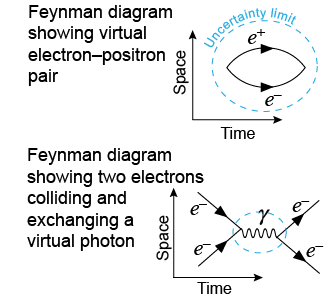|
In the quantum world, anything that can happen, does happen. In fact, unless something is specifically forbidden from happening, it must happen. As one example, consider the energy–time uncertainty relationship, which states that the total uncertainty in time and energy must be greater than h/4π. The uncertainty principle permits temporarily breaking the law of conservation of energy so long as the event reverses itself quickly enough. A particle might appear out of nothing, then disappear again if it happened so fast that it was within the energy and time limit of h/4π. 
|
 The quantum “vacuum” is not truly empty. There is considerable experimental evidence supporting the conclusion that virtual particles of matter and antimatter are continually popping into existence and disappearing again, out of pure nothing. Physicists use Feynman diagrams (named after theoretical physicist Richard Feynman) to represent quantum events such as virtual particle creation. In a Feynman diagram, time goes from left to right and space goes from bottom to top. The creation and annihilation of a virtual electron–positron pair is shown within the blue circle represented by Heisenberg’s uncertainty principle.
The quantum “vacuum” is not truly empty. There is considerable experimental evidence supporting the conclusion that virtual particles of matter and antimatter are continually popping into existence and disappearing again, out of pure nothing. Physicists use Feynman diagrams (named after theoretical physicist Richard Feynman) to represent quantum events such as virtual particle creation. In a Feynman diagram, time goes from left to right and space goes from bottom to top. The creation and annihilation of a virtual electron–positron pair is shown within the blue circle represented by Heisenberg’s uncertainty principle. 
|
The lower Feynman diagram shows the quantum interpretation of the collision between two electrons. Electrons repel each other through the exchange of a virtual photon. The photon is created and destroyed within the Heisenberg uncertainty limit so it can never be directly detected. The diagram illustrates that forces are transmitted by virtual particles! The electromagnetic force is transmitted through the exchange of virtual photons of light. 
|
Space and time on the quantum scale behave in very nonintuitive ways. The quantum world is in a constant state of random fluctuation. Quantum space itself is not a smooth, featureless void in which matter and energy exist. Instead the quantum vacuum is a continual chaotic storm of virtual particles flashing in and out of existence. This is one reason why it is impossible to predict the state of a quantum system. Even if you know the state of the system at one moment, random fluctuations make the next moment uncertain and the moment after that even more uncertain.

|

|
| |
|

